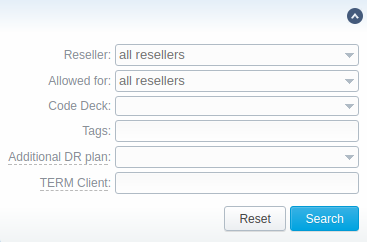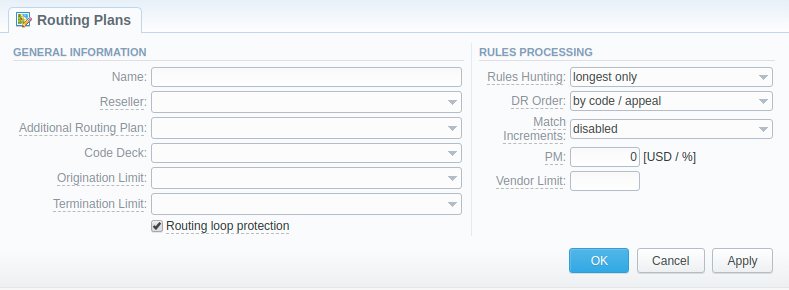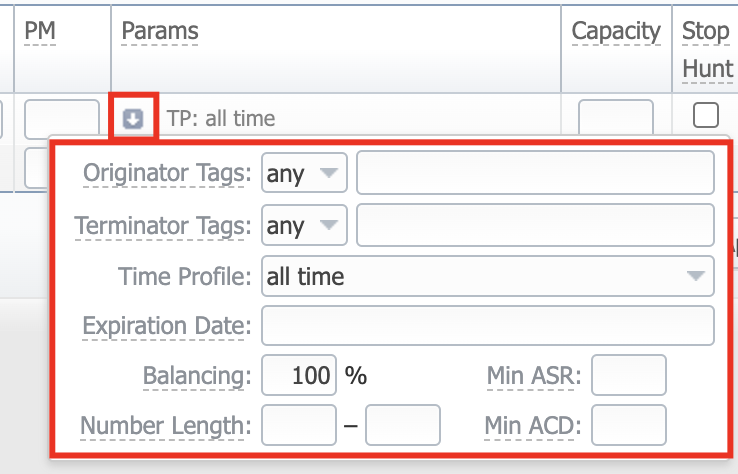Routing Plans
Section overview
The Routing Plans section is available if your JeraSoft Billing includes the Routing Module. To access the Routing Plans section, please log in to your system and go to Routing > Routing Plans.
This section allows managing your routing rules for customers, providers, and destinations. Each routing plan should be assigned to a respective customer (originator) for the proper work of the routing process.
You can combine both routing rules (dynamic and static) while creating a routing plan, also assign separate rules to each destination. Here you can find a list of created routing plans.

| Column | Description |
|---|---|
| ID | ID number of a routing plan |
| Name | Name of a routing plan |
| Reseller | Name of a reseller a corresponding routing plan has been assigned to as an owner |
| Code Deck | Name of code deck that has been applied to a corresponding routing plan |
| Rules Hunting | A respective hunting rule that has been applied to a routing plan |
| DR Order | A name of dynamic routing order that has been selected to organize routing rules |
| Rules | A number of rules specified in a respective routing plan |
Functional buttons/icons, presented in the section, are as follows:
| Button/Icon | Description |
|---|---|
 | Allows to create a new routing plan |
 | Allows to copy an existing routing plan to the section |
 | Allows deleting a routing planfrom the system |
Advanced Search
In the top right corner of the section above the table, an Advanced Search drop-down menu is located. By clicking on a blue downward arrow icon, a drop-down menu with the following structure is displayed:

| Field | Description |
|---|---|
| Reseller | Select from the list of all Resellers and Sub-resellers registered in the system |
| Allowed for | Select from the list of all Resellers and Sub-resellers that are assigned to a routing plan in the Origination Limit field |
| Code Deck | Select from the list of all Code Decks in the system |
| Tags | Specify a certain Tag that was added to a routing plan |
| Additional DR Plan | Select a routing plan that was assigned as an additional in the Additional Routing Plan field |
| TERM Client | Specify a termination client that was assigned to any routing plan rule |
To apply the specified search criteria, click the Search button; to cancel the applied parameters, click the Reset button.
Adding a New Routing Plan
To create a new routing plan, click the New Routing Plan button, and fill in the following fields in the pop-up window.

General routing plan information:
| Field | Description |
|---|---|
| Name | Title of a routing plan |
| Reseller | Define the reseller/owner of a current routing plan |
| Additional Routing Plan | Specify a DR plan, which will be additional for a current plan |
| Code Deck | Select a Code Deck if you wish to have names of your code to be specified in the Code Name field |
| Origination Limits | Define the company or companies, which will have access to this routing plan (also this restriction will be extended to their sub-companies). If there is no specified company, the following routing plan is available for all companies |
| Termination Limits | Select the company or companies, which will have a limit in termination for vendors who use it (sub-companies are not included) |
| Rooting Loop Protection checkbox | Excludes originating client from the list of terminators. If it is unchecked, it will be possible to route calls between different accounts of the same client. It is disabled by default |
Options of rules processing:
Rules Hunting – select a hunting mode (the way how rules will be executed). They are as follows:
- "longest only" – routing will find only the longest matching code;
- "all matching" – all possible matches will be found, including even the shortest codes.
By default, the longest only option is set.
DR Order – specify a method of routes sorting in a routing table. The options are:
- "by appeal/code" – routes will be sorted according to their resulting appeal value and then grouped by codes;
- "by code/appeal" – routes will be grouped by codes and then sorted by appeal value.
By default, the by code/appeal option is set.
Match Increments – define if the system should check whether Customers' increments proportionally overlap Vendors' increments:
-
"disabled" - selected by default;
-
"dynamic only" - will exclude vendors with increments that do not match customers' rates from the routing list for dynamic rules;
-
"dynamic and static" - will exclude vendors with increments that do not match customers' rates from the routing list for dynamic and static rules.
Sample ScenariosCustomer Rate Min Time Customer Rate Pay Interval Vendor Rate Min Time Vendor Rate Pay Interval Result Notes 60 60 60 60 OK Exact match 30 6 30 1 OK Full overlap 30 6 6 6 OK Full overlap 1 1 30 6 FAIL Vendor Increments are higher 7 7 6 6 FAIL Even though Customers increments are higher, with call duration of 7 seconds this case will lead to 7 seconds billed on customer and 12 seconds billed on vendor
PM – define a Profit Margin value for a current rule here. It can be specified either as a percent value (e.g., 16%), or in a system currency (e.g., 5 for 5 USD).
Vendor Limit – determine the number of allowed routes for the same vendor to use (if a vendor has multiple accounts). You can set the limit only for accepted account routes, not including the accounts blocked by the term groups. If the field is left empty, the number is unlimited.
The Origination Limit and Termination Limit fields are visible only during:
- new routing plan creation;
- editing of already created routing plan if a specified Reseller of this routing plan has at least one sub-reseller.
Routing Rules tab
Once a routing plan has been created, routing rules are to be determined (see screenshot below). To do that, click on a routing plan's name and you will enter Routing Rules tab, then, click the Add Rule button and fill in the following fields:

| Field | Description |
|---|---|
| Status | Uncheck the checkbox to disable the routing rule |
| Priority | Define a priority of rule execution if two or more rules have similar code or code name specified |
| Code | Enter a code, which will be used in a current routing rule, use * as a wildcard |
| Code Name | If you have a code deck assigned to this routing plan, a corresponding code name, specified in the Code field, will be displayed automatically. If no code deck is attached, the field will remain empty |
| Static Client rule type | If selected, in the Terminator / Policy field you can specify a certain termination client |
| Static Account rule type | If selected, in the Terminator / Policy field you can specify a certain termination account of a client |
| Dynamic rule type | If selected, in the Terminator / Policy field you can specify a certain dynamic policy for the rule |
| DID rule type | If selected, the Terminator / Policy and Code fields become inactive |
| Terminator / Policy | If you selected static type, you may specify a termination client/account here; if you selected dynamic type, specify routing policy for the current rule |
| PM | Define a Profit Margin value for a current rule here |
| Capacity | limit capacity for the current rule (leave blank for unlimited) |
| Stop Hunt checkbox | if this field is checked, this means that rule search will be stopped when matched with the current one and all the consecutive rules will not be executed for a current call. The logic will be respected even if the rule marked with "Stop Hunt" will be rejected due to some reason during routing |
If the PM field has been specified both for the entire routing plan and for a certain rule, the latter has a higher priority.
A number of additional parameters are available by clicking the downward arrow icon:
-
Originator Tags – you can specify respective originator tags here. If nothing is specified, it works for all.
- "all" - applies for originators if all specified tags are present.
- "any" - applies for originators if at least one of the specified tags is presented.
-
Terminator Tags – here you can add terminator tags that will be used for terminators. If nothing is indicated, it works only for terminators without tags. Please note, this parameter is available only for dynamic rules.
-
Time Profile – specify a time profile from the list
-
Expiration Date – here you can determine if a rule will expire or not. If a date/time is specified here, the respective rule will stop working after said timestamp. It will be removed from the Routing Plan completely after the next run of Dynamic Routing Manager. If empty, the said rule will work indefinitely.
noteIf the Expiration Date will be set for the past, it will be highlighted in red to draw attention that it's not in use. With the next run of Dynamic Routing Manager, the said Rule will be removed.
-
Balancing – define the percentage or proportion amount of traffic, which will be sent to a respective vendor who participates in balancing
infoPlease note that after changing balancing value, you will need to restart the Traffic Rules Manager or wait till its next run.
Among the rules of the same priority, balancing will not be performed if the value is 100 or more in the Balancing field.
Useful tipTo balance routes equally among, say, three vendors, you can set Balancing to 33/33/33 for them OR 1/1/1 OR 99/99/99, etc. As long as the values are equal and strictly less than a 100, the system will balance traffic between them accordingly:

-
Number Length – set minimum and maximum length of destination number that will be matched by this routing rule
-
Min ASR – specify minimum ASR (successful records percentage) value to reject the routes that don't correspond to it
-
Min ACD – specify minimum ACD (in Service units) value to reject the routes that don't correspond to it

Import/Export tab
The Import / Export tab allows a user to either upload desired routing rules (choose a file on a computer through a form and click Process), or download current routing plan rules in a .csv file by clicking the Process button.

Please pay attention that the column order in importing file must correspond to the one presented in the screenshot below.

After all information has been entered and rules created, you need to go to Management > Clients/Accounts sections and assign this routing plan to one or more of your origination clients or client's accounts.
Routing Plan tab
If you wish to change your routing plan settings, you can always do so by going to the Routing Plan tab. The list of fields in a tab is identical to that on a routing plan creation page.
